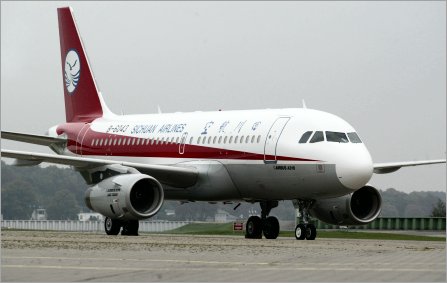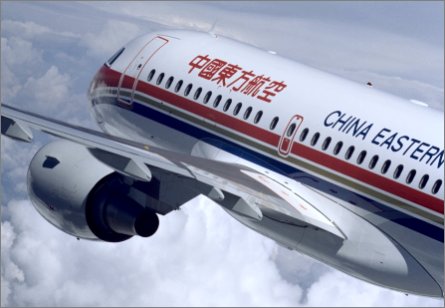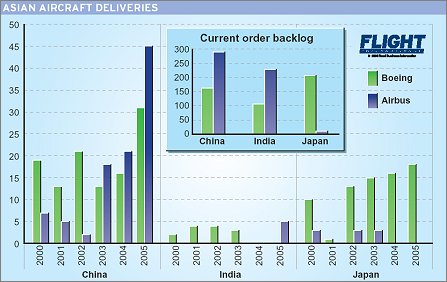The rapid expansion of Asian economies – particularly in China – is acting as a magnet for European investors. But will US sabre-rattling hold them back?
In the tradition of Marco Polo, Europe’s aerospace adventurers are plying a trade route to the Far East that promises riches and rewards, but also comes with risks. The commercial trail blazed by Airbus and Eurocopter looks to be lucrative, but the burning question is whether Europe’s defence industry will follow their lead, and at what cost?
|
Airbus sees huge potential in Chinese market and already has 325 aircraft in service |
Made in China?
Airbus made its first inroads into China in 1985, when it sold its first three aircraft to the country. Since then, the company has gained substantial ground, obtaining an unprecedented commitment for 150 A320-family aircraft last year. Part of the deal was a pledge to consider the possibility of setting up a final-assembly line for the narrowbody aircraft in China. Also last year, and after a similarly long engagement in the country, Eurocopter agreed to invest €300 million ($360 million) in co-developing the new helicopter, the EC175, with China’s AVIC II.
EADS co-chief executive Noel Forgeard is clear on the significance of the $10 billion Airbus deal, and stresses the company’s long-term commitment to the Chinese market. “There is a huge market potential,” he says. “We think China is the right partner with which to tackle the next 20 to 30 years.” Eurocopter chief executive Fabrice Bregier agrees, describing Asia as “the biggest growth market for the company”.
It is no surprise that China is considered the holy grail by many European manufacturers, with three consecutive years of 10% economic growth under its belt. Boeing forecasts 7.8% annual growth in Chinese air traffic, and predicts the market will need 2,612 new aircraft over the next 20 years. Airbus is even more bullish, predicting that traffic growth of between 8% and 10% a year will create a market for 1,790 aircraft with more than 100 seats alone by 2022 in China alone, making it the second-largest aviation market after the USA. As of September last year, 325 Airbus aircraft were in service in mainland China, Hong Kong and Macao – a 34% market share even before the recent orders are taken into account. But EADS’s plans for China involve expansion on a wider scale, to encompass everything from engineering design and development to product support and maintenance.
EADS forecasts that by 2015, 30% of its sales will come from the Asia-Pacific region, compared with 16% in 2004. The company’s focus is not just on China. Late last year, Eurocopter was selected to work with South Korea on development of a new military utility helicopter. EADS is also expected to announce the establishment of a new research and development centre in Singapore at next week’s Asian Aerospace show.
Aviation’s other favoured destination is India, and as low-cost carriers spring up to take advantage of the huge potential for growth in air traffic, Airbus forecasts Indian carriers will buy 600 aircraft worth over $60 billion by 2023: its goal is to win at least half of these orders.
Expanding India
And it is not just the potential for sales that attracts Western manufacturers to India: as the country’s middle class expands, foreign investors can take advantage of the growing numbers of English-speaking graduates available in a low-cost environment.
|
Airline services providers are positioning themselves to take advantage of the huge growth in air transport in the region |
High-profile aerospace companies are keen to stress they are not interested simply in the low-tech, low-cost labour for making simple components that Asian countries can provide. They are investing in skills, they point out. Engine manufacturer Rolls-Royce announced late last year it was setting up an engineering centre in Bangalore, citing the “capability that exists in India to develop, reliably and to consistently high-quality standards, affordable aero-engineering solutions – including engineering analysis and design capability”.
Although the European primes and tier-one players may downplay the significance of the low-cost manufacturing provided by Asian markets, smaller companies with tighter margins further down the supply chain can clearly benefit from the lower labour costs the region offers. For Europeans hit by dollar exposure in recent years, Eastern outsourcing can provide a valuable way to save on costs.
Toulouse-based supplier Latecoère is ensuring it has an industrial footprint with China through risk-sharing agreements with industry on the A350. The company is also guaranteeing continued business with Airbus by investing in a partnership in a key market for the aircraft manufacturer.
UK-based Doncasters is cautiously considering the region, studying the feasibility of setting up facilities in low-cost countries such as China. “It’s partly about having a low-cost source for our products,” says managing director aerospace Mike Askew, “but the strategic issue is market access – China is a very large and growing market and we have to ask ourselves if a presence there is necessary.” The company would need to identify products that would be repeatable in high volumes, with high value-added content, he says, adding: “This is where you optimise payback.” Doncasters is looking at China and India, among others, as markets that could give medium- to long-term reciprocal trading.
Electronics specialist Thales already generates on average €100-150 million in sales from China each year, and this figure looks set to grow. In aerospace, its main Chinese activities include an Airbus avionics subassembly repair shop for Chinese airlines as well as equipment for air traffic control centres in Beijing, Shanghai and Guangzhou.
The group is considering expansion in the training and simulation sector. “A number of simulation projects are being studied to manage the rapid growth of air traffic in China and the expansion of aircraft fleets that airlines will need to satisfy growing demands,” Thales says.
UK-based Smiths has long considered China a key market. The company has a production site at Suzhou, and is looking at doubling its size and adding manufacturing of actuation equipment and electronic components to its portfolio of engine components for General Electric and composite and structural materials for Airbus and Boeing. Smiths’ regional marketing director for the Far East Jon White also hints at further advances. “China is strategically important for us, and the support of our equipment in-country is also a priority for us. We are looking at options for increasing service provision.”
The move to place service and support close to key growing markets is part of a wider industry trend: as the primes recognise the need to head East to find new airline customers, service providers follow. UK-based Umeco is setting up a component logistics and distribution joint venture in Xian to support Western aerospace manufacturers including Airbus, Boeing, Goodrich and Rolls-Royce as they step up their production in China. Umeco also plans to support local players including Xian Aircraft and Xian Aero Engine.
Service ambitions
With the huge growth in air transport in the region, service providers to the new and expanding airlines are also positioning themselves to win Asian business. SR Technics chairman Frank Turner has cited Asia-Pacific as an important growth region that he wants to target. Shanghai SR Aircraft Technics, the company’s MRO joint venture with Shanghai Foreign Aviation Service Corp (FASCO) will begin operations in April.
|
European manufacturers’ ambitions are not constrained to the airliner market: EADS made a key move late last year with its sale of four Airbus Military A400M transports to Malaysia. The deal included initial high-technology work packages for Malaysian industry worth around €200 million. EADS is also making inroads into the Asian general aviation market with the EC175 helicopter project. Eurocopter says the Chinese helicopter market is growing by up to 15% a year and that the country will need 300 helicopters by 2015, as the 2008 Olympic Games in Beijing and the 2010 Universal Exhibition in Shanghai boost demand for civil applications from TV broadcasting to medical evacuation, and security to VIP transport.
R-R expects growth in the business jet market of $61 billion over the next 20 years in China, India and Russia. The forecast for these countries – based on the key drivers of economic activity, infrastructure growth and market liberalisation – is that 500-700 business jets will be delivered over the next decade, an increase of 600%.
Italy’s Finmeccanica, which earns more than 80% of its aerospace and defence turnover from the defence sector, has seen significant successes in Asia in both civil and defence aerospace, with joint ventures in Malaysia through radar division Selex Sistemi Integrati, as well as in space through Telespazio. In India, the group has won radar contracts for India’s military airports, while its success in China has so far been limited to a joint venture for the marketing, production and local support of AgustaWestland’s A109 helicopter.
While European companies have recognised the need to establish a presence in Asia, that does not mean it is all plain sailing. While low-cost manufacturing countries like China and India may seem an irresistible opportunity for European players keen to improve margins and offset the ongoing weakness of the dollar, the outsourcing of jobs to low-cost economies is a sensitive issue back home.
Reciprocal trading
However, Doncasters’ Askew points out that the possibilities for reciprocal trading offered by a presence in a low-cost economy could help to develop business and therefore safeguard jobs back home. “We’re looking to see where we may need to have a low-cost manufacturing facility to grow the company as a whole,” he says. A European manufacturer installing itself in the Far East must be prepared to commit to the project from close range in the short- to medium-term, he says: “It’s not possible to run an operation at arm’s length.” And, says one analyst, there is always a risk that companies will jeopardise their manufacturing operations back home through outsourcing too many of their key skills.
ADS’s high-profile helicopter project highlights another potential stumbling block for European investors in sensitive markets like China. Some observers have questioned the strategy behind developing a helicopter that, while its primary use is for civil purposes, could be modified for military use. Issues over technology transfer and security in China could damage EADS’s business prospects in the USA, one analyst warns. Washington has already issued dire warnings about the prospects for European defence sales to the USA if the arms embargo on China is lifted.
But with the importance of China on the world stage and the huge economic and air traffic growth that is forecast, the analyst believes EADS would be more likely to choose success in China at the expense of the US market than the other way round. Despite sensitive issues for companies to navigate, bullish growth forecasts for civil aerospace and the possibility of more military business ensure Asian markets are set to continue to form a key part of European aerospace manufacturers’ portfolio.
HELEN MASSY-BERESFORD / LONDON
Source: Flight International


























